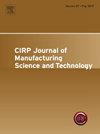Investigation of surface damage mechanisms in milling heat-treated pine wood
IF 4.6
2区 工程技术
Q2 ENGINEERING, MANUFACTURING
CIRP Journal of Manufacturing Science and Technology
Pub Date : 2025-02-01
DOI:10.1016/j.cirpj.2024.11.005
引用次数: 0
Abstract
Heat-treated pine wood is commonly utilized in the furniture and construction sectors, with milling being a key technique to enhance the surface quality of these products. To investigate the milling surface damage mechanism of heat-treated wood, a milling test of pine wood was conducted after different heat treatments, and the effects of heat treatment temperature and cutting parameters (cutting depth and feed per tooth) on cutting force and surface roughness were analyzed. The experimental and analytical results of these cutting tests indicate that higher heat treatment temperature resulted in reduced wood strength, leading to a reduction in cutting force as the heat treatment temperature increased. Additionally, the brittleness of wood increased with increasing heat-treatment temperature, which caused more burrs and wood tissue fragments to appear on the machined surface, resulting in increased surface roughness. Increasing cutting depth from 0.1 mm to 0.5 mm raises cutting force and surface roughness for untreated and heat-treated wood. For depth, force increases by 35.5% to 15.32% and roughness by 75.8% to 84.7%. For feed speed from 0.2 mm/Z to 0.6 mm/Z, force increases by 37.55% to 34.56% and roughness by 58.38% to 91.4%. This study investigates the milling surface damage mechanisms of heat-treated wood, filling the gap in the literature that has focused on the effects of cutting parameters on surface roughness without examining surface damage mechanisms, providing a theoretical basis for optimizing the processing technology of heat-treated wood.
求助全文
约1分钟内获得全文
求助全文
来源期刊

CIRP Journal of Manufacturing Science and Technology
Engineering-Industrial and Manufacturing Engineering
CiteScore
9.10
自引率
6.20%
发文量
166
审稿时长
63 days
期刊介绍:
The CIRP Journal of Manufacturing Science and Technology (CIRP-JMST) publishes fundamental papers on manufacturing processes, production equipment and automation, product design, manufacturing systems and production organisations up to the level of the production networks, including all the related technical, human and economic factors. Preference is given to contributions describing research results whose feasibility has been demonstrated either in a laboratory or in the industrial praxis. Case studies and review papers on specific issues in manufacturing science and technology are equally encouraged.
 求助内容:
求助内容: 应助结果提醒方式:
应助结果提醒方式:


